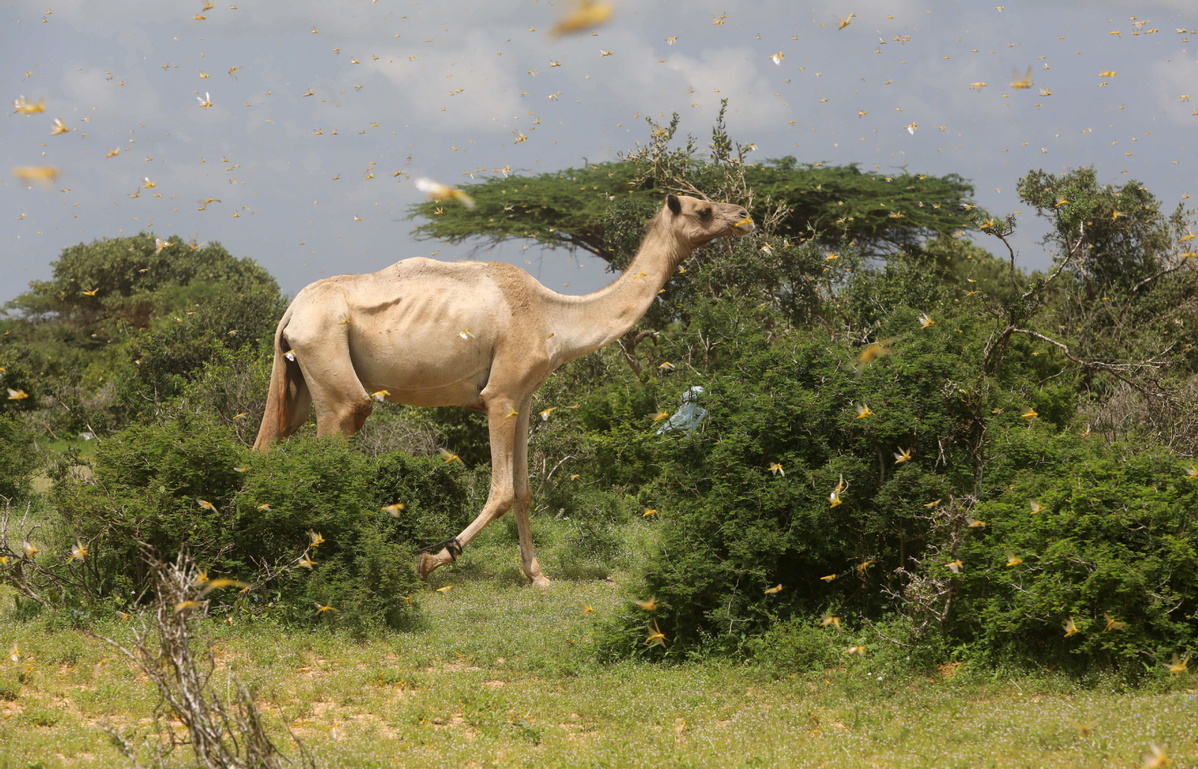Farmers worry as locusts return to East Africa
By EDITH MUTETHYA in Nairobi, Kenya | China Daily Global | Updated: 2020-11-24 09:03

Farmers in East Africa are very concerned after seeing desert locusts in various parts of the region, despite continued efforts since last year by governments and partners to eliminate the destructive pests.
In Kenya's Kitui County, fear was written on farmers' faces on Sunday after they noticed desert locusts at a time when their crops are sprouting following the ongoing brief rains.
The sightings come as the Kenya Meteorological Department predicts that the country will experience depressed rainfall during this short rain season.
Peter Munya, the Cabinet secretary for agriculture, livestock, fisheries and cooperatives, confirmed on Saturday that fresh swarms of desert locusts had been spotted in Mandera, Wajir, Garissa, Isiolo, Tana River, Kitui and Taita-Taveta counties.
Munya said that while Kenya had succeeded in eliminating locusts by September, Ethiopia and Somalia didn't eradicate the pests, so the locusts have been breeding in those countries and are migrating to Kenya.
Despite a regional body that has a mandate to fight desert locusts, Munya said a lack of regional cooperation was to blame for the failure to effectively control the pests.
"We even send some of our chemicals to Yemen in efforts to support the other countries to control locusts from the source. Unfortunately, control efforts in those countries have not been effective," he said.
Munya assured Kenyans that the ministry is fully prepared to curb the spread of the locusts, and said the government, along with development partners including the United Nations' Food and Agriculture Organization, has set aside $29.2 million to deal with the imminent crisis.
"Besides livestock related interventions in pastoral counties, we are also undertaking crop livelihood interventions in all the counties affected by the invasion. This includes distribution of certified seeds, water harvesting pots and fertilizers," he said.
Munya said that the ministry will mobilize spray aircraft and that the bases created during the previous locust invasion have been reactivated and are ready to face the second invasion.
Carla Mucavi, the FAO's country director for Kenya, said there is a plan of action to deal with the second wave of locust invasion and that the agency will continue to provide the required support to eliminate the pests.
During the past week, strong northerly winds have carried small mature swarmlets of locusts south from southern Somalia to northeast and eastern Kenya. A few swarmlets continued farther south to Taita-Taveta County and nearly reached northeast Tanzania, the FAO said.
Although some of the swarmlets that arrived in Kenya may already have laid eggs in southern Somalia before their arrival, the FAO said there remains a risk of further egg-laying in sandy areas of northeast Kenya where there has been recent rainfall. In addition, there is a risk of the formation of hopper bands-cohesive masses of locusts in the nonflying hopper or nymphal stage.
The UN agency said breeding is ongoing in central Somalia and eastern Ethiopia, where hopper bands are present, and a new generation of immature swarms will start forming by the end of this month.
"Swarm formation will continue throughout December," the FAO said. "From the second week of December onward, several waves of numerous swarms can be expected to move south in Somalia and Ethiopia, reaching northern Kenya."
Intensive aerial and ground control operations are being carried out in the three countries.
In Eritrea, the FAO said ground control operations continue against groups of hoppers and adults in winter breeding areas on the northern coast of the Red Sea.
Aerial and ground control operations are also ongoing in Sudan against hopper bands and swarms in the summer breeding areas east of the Nile Valley. Control is also underway against maturing swarms in the winter breeding areas on the Red Sea coast in the country's Tokar Delta region.
The FAO said control teams are also fighting a few hopper groups and bands that have formed in one area in southern Egypt.
























